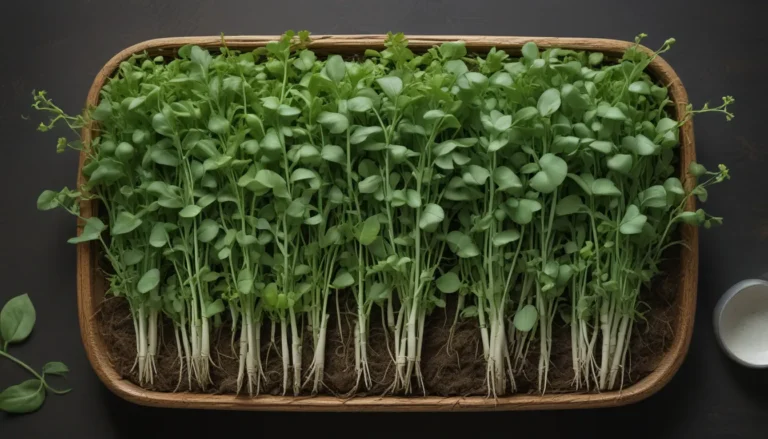A Comprehensive Guide to Identifying and Controlling Common Pests in Your Cabbage Garden

If you’re a home gardener, you’ve probably experienced the frustration of pests ruining your hard work in the garden. From hornworms attacking tomatoes to slugs devouring lettuce, pests seem to be an inevitable part of gardening. Cabbages, in particular, are susceptible to a wide range of pests that can cause significant damage if left unchecked.
Cabbage belongs to the Brassica genus, which also includes broccoli, cauliflower, brussels sprouts, and kale. Pests that target cabbage often attack other brassica crops as well. This means that if you find pests on one crop, they may be infesting all of them in your garden.
In this in-depth guide, we’ll explore common cabbage pests, their warning signs, and effective ways to control them. By planning ahead and implementing preventative measures, you can protect your cabbage plants from pests and reduce the chances of infestation. Let’s make a plan to safeguard your cabbage crop!
What You’ll Learn
- Planning Ahead
- Common Cabbage Pests
- Aphids
- Cabbage Maggots
- Caterpillars
- Armyworms
- Cabbage Loopers
- Cabbage Webworms
- Cutworms
- Diamondback Moth Caterpillars
- Imported Cabbage Worms
- Flea Beetles
- Slugs and Snails
- Spider Mites
- Stink Bugs
- Whiteflies
- Wireworms
- Mammals
- Deer
- Groundhogs
- Rabbits
Planning Ahead
As gardeners, we have centuries of agricultural knowledge to draw upon when dealing with pests in our gardens. By planning ahead and employing proven strategies, we can protect our crops from infestation. Here are some tips to consider when planning for a successful cabbage crop:
- Increase Plant Diversity: Plant a variety of crops to ensure a higher yield even in the presence of pests.
- Provide Adequate Spacing: Proper plant spacing can prevent the spread of infestations and diseases.
- Keep a Garden Journal: Documenting pest observations and infestation locations can help in planning preventative measures.
- Practice Crop Rotation: Avoid planting the same crop in the same area every year to reduce the risk of persistent pests.
- Protect Crops: Use physical barriers like row covers or mesh to shield plants from pests.
- Encourage Beneficial Insects: Introduce ladybugs, praying mantises, or green lacewing flies to combat problematic pests.
- Consider Winter Planting: Winter crops like brassicas can help prevent infestations in the spring.
- Use Beneficial Nematodes: Predatory nematodes can help control pests like wireworms in the soil.
Common Cabbage Pests
Aphids
Aphids are notorious for their ability to infest a wide range of plants, including cabbage. Gray-green cabbage aphids are common on brassicas and can cause significant damage if left unchecked. Signs of aphids include yellowing and curling leaves and stunted growth. To control aphids, consider smashing them, applying neem oil or insecticidal soap, and introducing beneficial predatory insects like ladybugs.
Cabbage Maggots
Cabbage maggots, the larvae of a small fly species, target brassicas like cabbage and broccoli by feeding on plant roots. Signs of infestation include yellow or purple leaf discoloration, wilting, and tunnels in stems. To manage cabbage maggots, you can use cultural practices like deep tilling, introducing beneficial nematodes, and setting traps to lure larvae.
Caterpillars
Various caterpillars can damage cabbage plants, such as armyworms, cabbage loopers, cabbage webworms, cutworms, and imported cabbage worms. These larvae can cause extensive foliage damage, leading to plant dieback and reduced yields. Implementing cultural controls, introducing beneficial insects, and using traps can help manage caterpillar infestations.
- Armyworms: Large groups of caterpillars that feed on plants and can cause severe damage.
- Cabbage Loopers: Green caterpillars with looping movements that feed on leaves and buds.
- Cabbage Webworms: Larvae that form web-like pockets on cabbage plants and cause leaf damage.
- Cutworms: Soil-dwelling larvae that cut through plant stems at the base, causing plant collapse.
- Imported Cabbage Worms: Larvae of the cabbage white butterfly that feed on cabbage leaves.
Flea Beetles
Flea beetles can rapidly damage cabbage plants by creating shot holes in leaves. Adult beetles are small and come in various colors, ranging from black to iridescent blue-green. Preventive measures like tilling, delaying planting, and using row covers can help reduce flea beetle infestations. Introducing beneficial nematodes, using traps, and planting companion plants like marigolds can also be effective in controlling these pests.
Slugs and Snails
Slugs and snails are notorious for their ability to devour cabbage leaves, leaving behind stubby stumps. These pests are most active during cool, damp evenings and nights. You can control slugs and snails by removing debris from the garden, setting beer traps, using copper flashing, diatomaceous earth, and eggshells, and planting companion plants like marigolds and garlic.
Spider Mites
Spider mites are tiny arachnids that feed on plant sap, causing wilting and discoloration of cabbage plants. Preventive measures like planting marigolds, garlic, or lemongrass can help deter spider mites. Using insecticidal soap and neem oil, providing supplementary irrigation, and allowing access to predatory insects can also aid in controlling spider mite infestations.
Stink Bugs
Stink bugs like the harlequin bug can damage cabbage by piercing plants and sucking sap. These insects can spread diseases and cause wilting and discoloration of plants. To control stink bugs, you can physically remove them from plants, set traps, and use neem oil. Utilizing row covers, planting companion plants, and encouraging predatory insects can also help manage stink bug populations.
Whiteflies
Whiteflies, like Aleyrodes proletella, are tiny insects that feed on cabbage plants by sucking plant sap, leading to discoloration and sooty mold. These pests can spread diseases and reproduce rapidly. Preventive measures like inspecting plants for eggs, using insecticidal soap, and introducing predatory insects can help control whitefly populations.
Wireworms
Wireworms, the larvae of click beetles in the Agriotes genus, can damage cabbage crops by feeding on plant roots. These soil-dwelling pests can live in the soil for years, causing stunted growth and plant damage. Effective management strategies for wireworms include deep tilling, using wire traps, introducing beneficial nematodes, and setting traps with potatoes to lure larvae.
Mammals
Deer
Deer can pose a significant threat to cabbage crops by grazing on plants, especially in cooler seasons. Preventing deer access to the garden through fencing and row covers can help protect cabbage plants.
Groundhogs
Groundhogs can chew through plants, including cabbage, and burrow beneath barriers. Implementing wire fencing or trapping and relocating groundhogs can prevent crop damage.
Rabbits
While rabbits may not actively target cabbage, they can still consume plants if other food sources are scarce. To protect cabbage plants from rabbits, use wire fencing, row covers, and raised beds to limit access.
Protecting Your cabbage Crop Can Be Quite the Undertaking
Cabbage is a versatile and nutritious crop that deserves protection from common pests. By identifying early warning signs, implementing preventive measures, and employing effective pest control strategies, you can safeguard your cabbage plants and enjoy a bountiful harvest. Remember to stay vigilant and take proactive steps to prevent infestations in your garden. With proper planning and careful management, you can protect your cabbage crop from pests and ensure a successful growing season.
If you found this guide helpful, let us know in the comments below! And be sure to explore additional resources on growing cabbage at home for more tips and information. Happy gardening!





